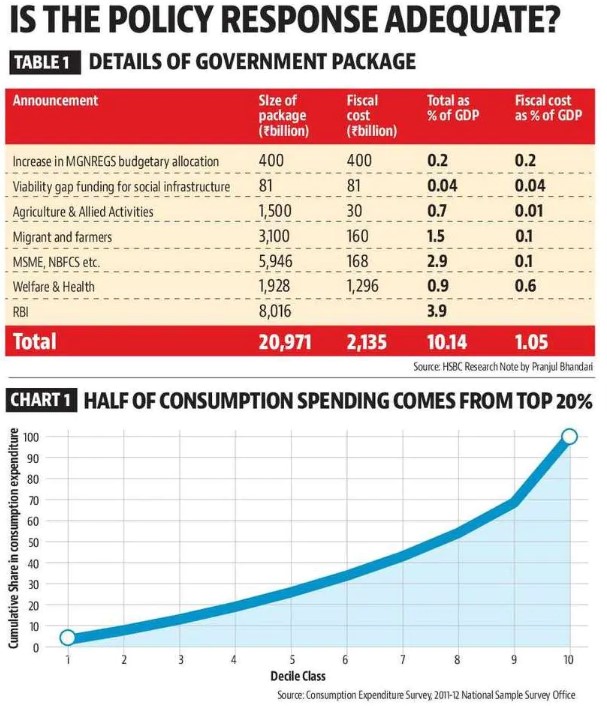Focus: GS-III Indian Economy
Why in news?
- The actual fiscal spending involved is much lower than the Economic Stimulus package which is said to amount to over ₹20 lakh crore (10% of GDP)
- The reason for this is that two-thirds of the package is focused on credit infusion programmes.
- This implies that supply side measures such as easing credit supply are unlikely to help boost the economy, although some businesses may benefit from it.

Where does demand come from?
In a modern economy, demand comes from three sources:
- domestic consumption
- exports
- investment.
Imports represent negative demand, as local purchasing power is diverted towards foreign goods.
Export issues
With the multilateral trading regime in jeopardy, rise of protectionism and trade wars and shock of the pandemic, exports are unlikely to revive anytime soon.
Another factor which will prevent an export surge is India’s inability to join any major regional trade treaty.
Domestic Consumption
Private Final Consumption Expenditure has had a share of almost 60% of India’s GDP in the recent period. India’s private spending is very unequal in nature. An analysis of 2011-12 NSSO data (latest available figures) shows that almost half of it came from the top 20% of the population.
Income Inequality
An analysis of income tax data shows that 90% of income taxes in India came from the top 5% of the 50 million who even file income tax returns.
Issue with Boosting Consumption Demand
Precautionary savings tend to rise under conditions of income uncertainty.
There is thus a strong likelihood that the income uncertainty people are experiencing right now will nudge Indian households to increase precautionary savings at least for the next few years.
Investment as a driver of growth
Demand for capital goods is a derived demand; unless businesses see future growth in domestic demand or exports, they will not invest.
The concept of paradox of thrift
The concept of paradox of thrift developed by John Maynard Keynes says that if everybody were to start saving more in an economy, aggregate demand would go down. This will lead to lower incomes. Because savings are a fraction of income, collective savings will go down as well.
Way Forward: What can be done?
Food Security
- NSSO data shows that at least half of India’s population spent half of its budget on food – hence, a rise in food prices hurts the poor.
- There is merit in focusing on the bottom 80% of the population.
- An expansion of the current food security programme could benefit both farmers and consumers.
- One such way could be allowing employment of MGNREGS workers in private agricultural activity.
Health and Education
- Another area where things can be changed in the medium to long term is health and education services.
- In India, even the poor spend beyond their means on private education and healthcare.
Investment in food security, health, education etc. is generally seen as a resource diversion from physical infrastructure which directly promotes growth.
State spending in the food economy and social sector, even with stagnant or slightly lower wages, could free up a greater amount for spending by the poor in the non-farm economy.
-Source: Hindustan Times





